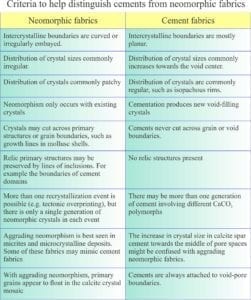

Pervasive neomorphism of this oolite sand has increased calcite crystal size overall, and in the process has overprinted the primary concentric layering. Plain polarized light.
The term neomorphism is reserved for recrystallization of a mineral and its polymorphs to new crystal phases having the same composition. In calcium carbonates this involves recrystallization of calcite, high-magnesium calcite, and aragonite to calcite (usually low-magnesium calcite). Dolomites are also prone to neomorphism (dolomite to dolomite replacement); note that the replacement of calcite or aragonite by dolomite is not a neomorphic process. Neomorphism commonly results in an increase in crystal size and the destruction or overprinting of original fabrics.
The actual process of neomorphism is still a bit of mystery. Initiation of recrystallization begins with dissolution at the crystal-fluid interface. Subsequent precipitation must involve changes in the local thermodynamic conditions (such as increased saturation, or a change in the activity of carbonate species). If crystal size continues to increase (via syntaxial growth) then the transfer of dissolved mass to the crystal interface must continue.
Neomorphic versus cement textures
Cements grow by precipitating into the available inter- or intragranular pore space. Thus, crystal faces are free to grow and therefore they tend to be planar, with sharp crystal edges and terminations. In contrast, the locus of neomorphic replacement of pre-existing crystal masses (e.g., cements, bioclasts) and subsequent precipitation will tend to be focused along crystal discontinuities such as cleavage and twin planes, as well as crystal edges and terminations, in part because they are regions of higher surface free energy. Thus, neomorphic crystal boundaries are commonly irregular and characterised by embayments, re-entrants, or segmented.
Neomorphic replacement of carbonate cements, bioclasts, microbial laminates, and mudrocks commonly proceeds fastest in fine-grained deposits such as micrite – again this may be a function of higher surface free energies relative to much larger crystals and coarse-grained clasts.
Recrystallization may also show a progressive change in crystal size – referred to as aggrading neomorphism. Crystal aggradation can mimic pre-existing cement fabrics where crystal size increases from the cement boundary into pore spaces. Aggrading neomorphism is common in carbonate mudrocks; the resulting textures appear clotted, where remnant patches of micrite appear to float among clusters of coarser crystals. This kind of texture is also called structure grumeleuse after Lucien Cayeux. Clotted textures may also be pellet-like; the distinction between original peloidal textures and these neomorphic fabrics requires careful attention. Neomorphic fabrics frequently cut across cement and clast boundaries.
Some criteria that distinguish neomorphic from cement fabrics are listed below; the information is gleaned from R.L. Folk (1968), Robin G.C. Bathurst Chapter 12 (1976), J.W. Morse and F.T. Mackenzie 1990, and Erik Flugel. (2010, Chapter 7).
And in thin section…
Intercrystal boundaries in cements


Intragranular calcite cement in bryozoa pores (the much smaller, dark, circular bodies within the bryozoan structure are zooids). Cementation began with small, bladed calcite crystals lining pore walls, overlain by coarser, more-or-less equant spar. Most intercrystal boundaries are straight. Boundaries that appear curved actually consist of smaller, straight-edge segments. Left: Plain polarized light. Right: Crossed polars. Sample is from the Oligocene Te Kuiti Group.
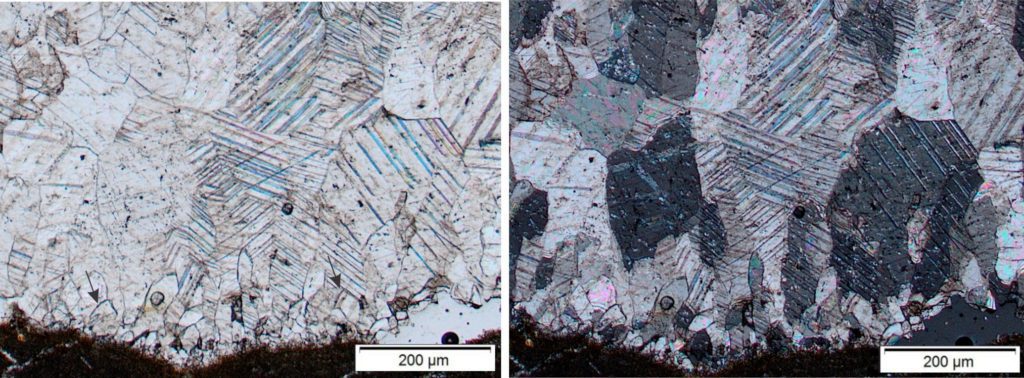

Detailed view of cavity-filling cement fabrics in coarse calcite spar. Crystal boundaries are mostly straight (planar) and terminations are sharp. There is a gradation in crystal size from small, scalenohedral crystals lining the cavity wall (arrows, bottom of image) to much coarser spar in the cavity interior. Some of these smaller crystals may have developed incipient neomorphism. Left: Plain polarized light. Right: Crossed polars.
Neomorphic fabrics
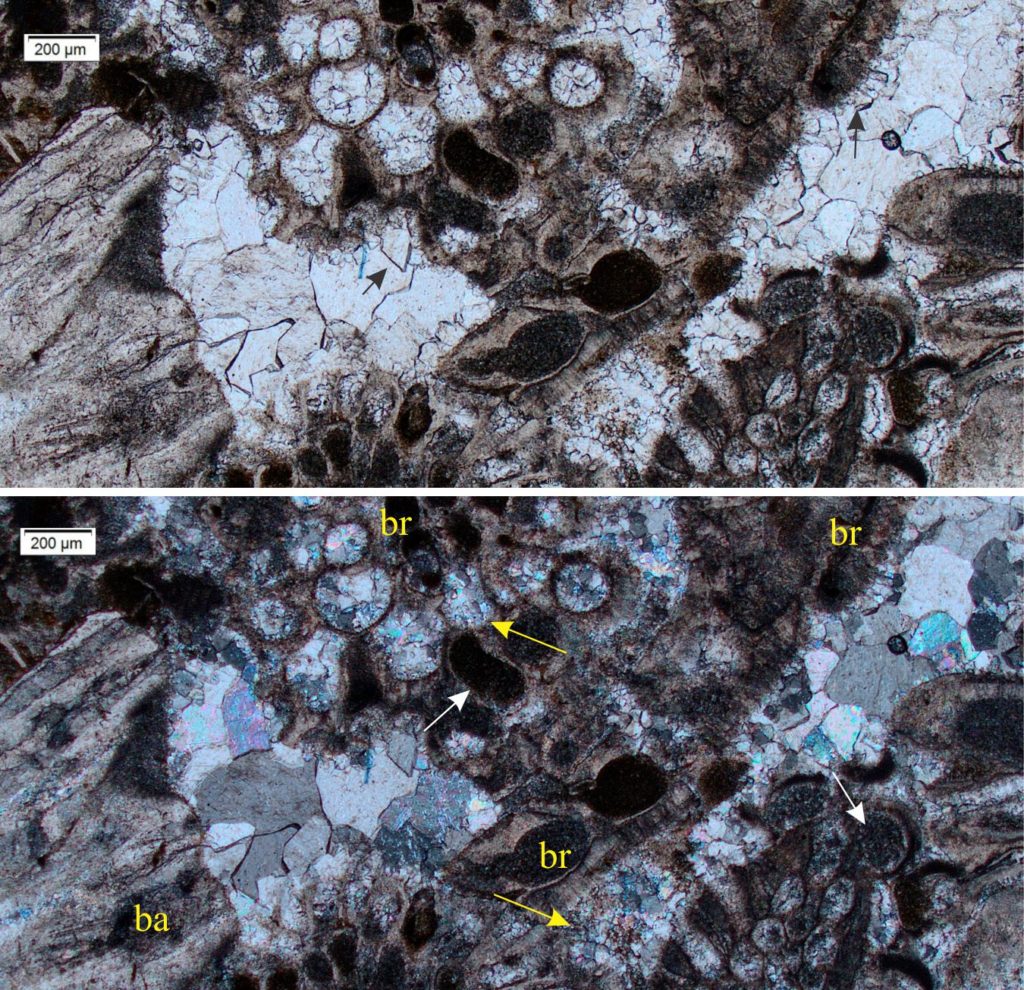

A mix of cement and neomorphic textures.
Inter- and intragranular calcite spar cements in Oligocene barnacle (ba) – bryozoa (br) limestone. Some of the smaller crystals lining bioclast rims have scalenohedral terminations (back arrows). The bryozoan intragranular zooid pores are filled with dark brown micrite (white arrows), but in some the micrite has recrystallized to calcite spar (yellow arrows). In this case, crystal boundaries are less distinct because the neomorphic spar is intergrown with remnant micrite. Top: Plain polarized light. Bottom: Crossed polars.
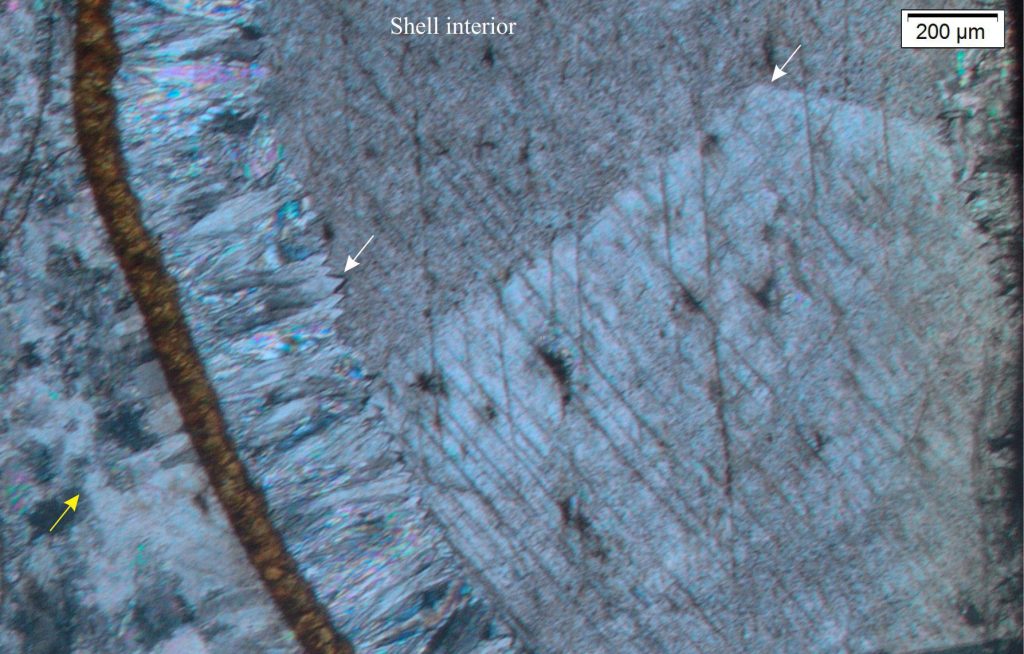

Contrasting neomorphic and cement textures in a Jurassic bivalve.
Neomorphic fabrics in the (possibly aragonitic) shell preserve some of the original crossed-lamellar structures that parallel the shell wall (yellow arrow). Crystal boundaries are highly irregular, producing an irregular interlocking framework. In contrast, cementation of the shell interior (where the animal once resided) began with isopachous, scalenohedral calcite that was followed by coarse calcite spar. The skinny brown layer is the interior shell wall, now replaced by siderite. Crossed polars.
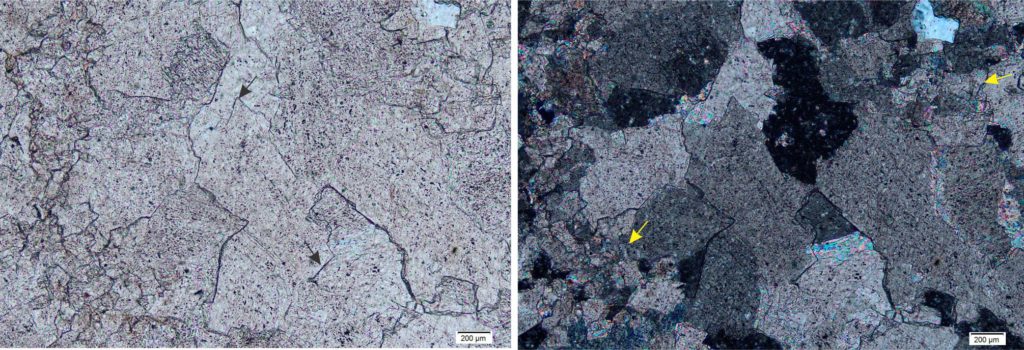

A mix of dolomite spar cement and finer neomorphic dolomite in a late Precambrian cryptalgal laminate, Tindir Group, Alaska. The large dolomite crystals preserve original crystal faces and terminations. The patches of finer dolomite crystals have boundaries that are more embayed or diffuse (arrows); the patches appear to float in the coarser fabrics. Left: Plain polarized light. Right: Crossed polars.


A bored gastropod shell in which neomorphic calcite has replaced the original lamellar CaCO3 (possibly aragonite). Traces of the original lamellar are preserved along (brown) bands of inclusions (white arrow); the neomorphic crystal boundaries cut across these structures (yellow arrows). However, also note the tendency for crystal elongation parallel to the relict lamellar textures – an indication that recrystallization was partly controlled by these earlier fabrics. Where the relict lamellae are not preserved, the calcite crystals assume a more equant, sparry habit. The boundaries of all neomorphic calcite crystals are irregular and embayed (e.g., red arrow).
The shell borings are filled with mud and silt-sized quartz and lithic grains, derived from the host sediment. Jurassic Bowser Basin. Left: Plain polarized light. Right: Crossed polars.


Neomorphism doesn’t just occur in carbonate lithologies. Here is thoroughly neomorphosed calcite in an Early Proterozoic pumice-ash tuff, Flaherty Fm. Note the highly irregular intercrystal boundaries in the coarse textures filling the shard bubble. Left: Plain polarized light. Right: Crossed polars.
Aggrading neomorphism


Aggrading neomorphism in these ooids has overprinted most of the original concentric and radial fabrics. Neomorphism is most advanced in the cores of each ooid. Maximum crystal size is 60-80 μm in ooid cores (yellow arrow), becoming finer towards the outer rims. The outer rim of each ooid has a fuzzy appearance due to recrystallization of the outer carbonate layer and the intergranular calcite cement. Several ooids have grown around fine sand-sized quartz grains (white arrow) or lime mud grains (red arrow). Left: Plain polarized light. Right: Crossed polars.
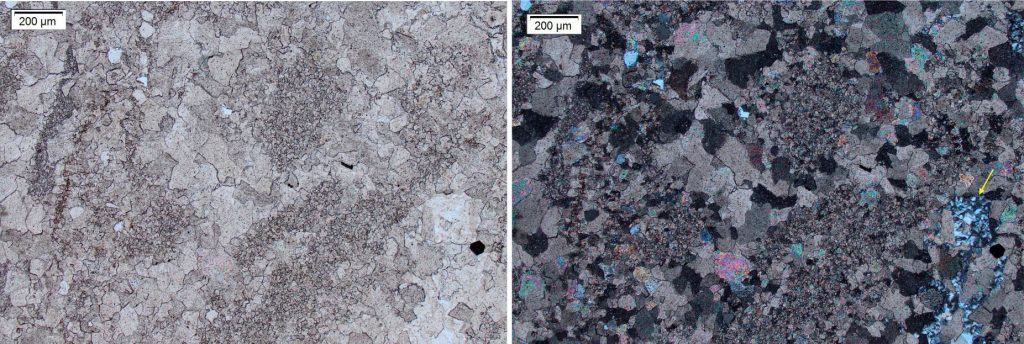

Aggrading neomorphism in this late Proterozoic cryptalgal laminated dolostone has produced a good example of structure grumeleuse, where clots of remnant micrite appear to ‘float’ within coarser, sparry, neomorphic dolomite. The boundaries of each clot are indistinct. The gradation from micrite to coarser spar may be gradual or relatively abrupt. There is a complete range of crystal sizes from micrite to 200 μm. There is a small patch of chert at lower right (arrow). Tindir Group, Alaska. Left: Plain polarized light. Right: Crossed polars.
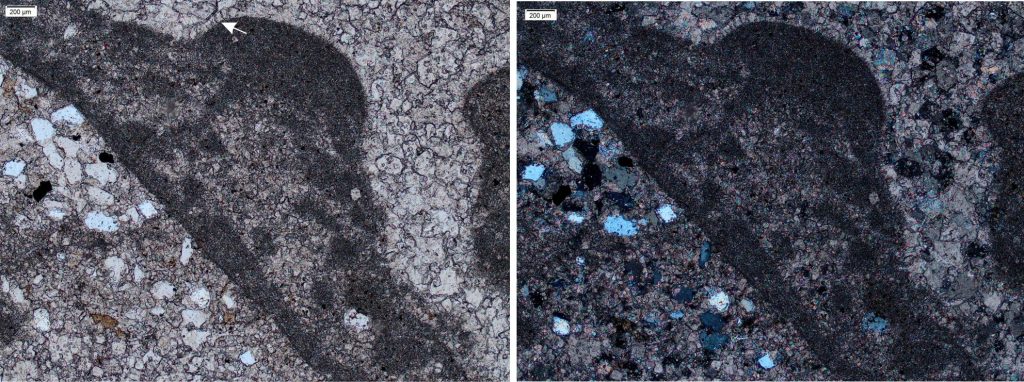

Typical clotted texture in neomorphosed micritic dolostone. Remnants of the original cryptalgal layering are still visible. The central laminate fragment occurs with other rip-ups and disrupted, overturned microbial mats. Although less obvious, the clotted texture extends into the surrounding field of (slightly sandy) dolomite spar. Most of the crystal boundaries are irregular and embayed, indicating that neomorphism was pervasive. There are hints of relict isopachous cements on the cryptalgal fragment rims (arrows) but I cannot determine their original composition based on optical microscopy alone. Tindir Group, Alaska. Left: Plain polarized light. Right: Crossed polars.
Acknowledgement
Thanks to Annette Rogers and Kirsty Vincent, Geology at Waikato University, for access to the petrographic microscope.
Other posts in this series
Optical mineralogy: Some terminology
Carbonates in thin section: Forams and Sponges
Carbonates in thin section: Bryozoans
Carbonates in thin section: Echinoderms and barnacles
Carbonates in thin section: Molluscan bioclasts
Mineralogy of carbonates; skeletal grains
Mineralogy of carbonates; non-skeletal grains
Mineralogy of carbonates; lime mud
Mineralogy of carbonates; classification
Mineralogy of carbonates; carbonate factories
Mineralogy of carbonates; basic geochemistry
Mineralogy of carbonates; cements
Mineralogy of carbonates; sea floor diagenesis
Mineralogy of carbonates; Beachrock
Mineralogy of carbonates; deep sea diagenesis
Mineralogy of carbonates; meteoric hydrogeology
Mineralogy of carbonates; Karst
Mineralogy of carbonates; Burial diagenesis
Mineralogy of carbonates; Neomorphism
Mineralogy of carbonates; Pressure solution
Mineralogy of carbonates: Stromatolite reefs

